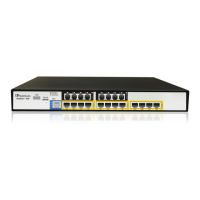User's Manual 576 Document #: LTRT-12809
Mediant 800 MSBR
7. To enable Internet Group Management Protocol (IGMP) multicasting:
a. Under the 'Internet Group Management Protocol (IGMP)' group, select the
'Enabled' check box. When a host sends a request to join a multicast group, the
device listens and intercept the group's traffic, forwarding it to the subscribed
host. The device keeps record of subscribed hosts. When a host requests to
cancel its subscription, the device queries for other subscribers and stops
forwarding the multicast group's traffic after a short timeout.
♦ IGMP Fast Leave: if a host is the only subscriber, the device stops
forwarding traffic to it immediately upon request (i.e., no query delay).
♦ IGMP Multicast to Unicast: the device converts incoming multicast data
stream into unicast format to route it to the specific LAN host that requested
the data. Therefore, the device prevents flooding the rest of the LAN hosts
with irrelevant multicast traffic.
8. To add a route entry according to the interface from which DNS record is received,
under the 'Domain Routing' group, select the 'Enabled' check box. When the device's
DNS server receives a reply from an external DNS server, it adds a routing entry for
the IP address of the reply through the device from which it arrived. This means that
future packets from this IP address are routed through the device from which the reply
arrived.
9. Click OK to save the settings.
45.2 Configuring Dynamic Routing
You can configure the following dynamic routing:
Border Gateway Protocol (BGP): The main routing protocol of the Internet. It is used
to distribute routing information among Autonomous Systems (for more information,
refer to the protocol's RFC at http://www.ietf.org/rfc/rfc1771.txt).
Open Shortest Path First Protocol (OSPF): An Interior Gateway Protocol (IGP)
used to distribute routing information within a single Autonomous System (for more
information, refer to the protocol's RFC at http://www.ietf.org/rfc/rfc2328.txt). The
feature's routing engine is based on the Quagga GNU routing software package. By
using the BGP and OSPF protocols, this routing engine enables the device to
exchange routing information with other routers within and outside an Autonomous
System.
Routing Information Protocol (RIP): Enables the RIP. RIP determines a route based
on the smallest hop count between source and destination.
If the OSPF daemon is activated, the device starts sending the 'Hello' packets to other
routers to create adjacencies. After determining the shortest path to each of the
neighboring routers, Zebra updates the routing table according to the network changes. If
the BGP deamon is activated, the device starts to advertise routes it uses to other BGP-
enabled network devices located in the neighboring Autonomous System(s). The BGP
protocol uses TCP as its transport protocol. Therefore, the device first establishes a TCP
connection to routers with which it communicates. KeepAlive messages are sent
periodically to ensure the liveness of the connection. When a change in the routing table
occurs, the device advertises an Update message to its peers. This update message adds
a new route or removes the unfeasible one from their routing table.

